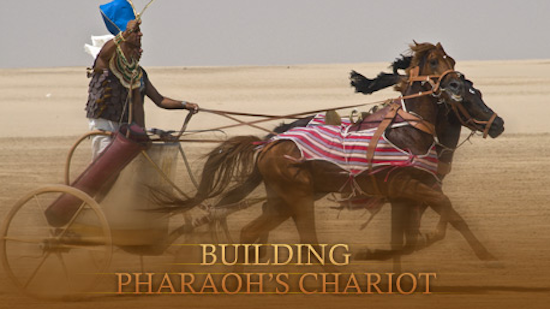UW–Madison engineer is expert for NOVA chariot documentary

An epic drama set in ancient Rome, “Ben-Hur” captivated filmgoers in 1959 with its majestic cinematography, powerful musical score, and thrilling, bloody nine-minute chariot race, which has become one of cinema’s most widely known sequences.
Now, “Building Pharaoh’s Chariot,” a new NOVA PBS documentary, follows a team of experts who built two accurate replicas of Egyptian royal chariots and pushed them to their limits in the desert outside Cairo.
The documentary features Bela Sandor, a professor emeritus of engineering physics at the University of Wisconsin–Madison and an international expert on the techno-archaeology of chariots.
Built to be lightweight, stable and strong enough to withstand violent maneuvers, chariots, says Sandor, are an engineering marvel. “Their engineering was stupendous,” he says. “Modern engineers could not do any better with only wood, leather and glue.”
Sandor was the sole technical expert for the one-hour documentary, which airs in Madison Feb. 6 at 8 p.m. on Wisconsin Public Television.
He saw “Ben-Hur” shortly after it debuted. He, too, marveled at the charioteers’ skill and their chariots’ maneuverability — but didn’t begin studying them as a research subject until his second trip to Cairo nearly 40 years after the film’s debut. There, at the Museum of Egyptian Antiquities, he noticed an inexplicable crack in a spoke on the wheel of one of King Tutankhamun’s chariots.
“Modern engineers could not do any better with only wood, leather and glue.”
Bela Sandor
And Sandor, an expert in fracture, fatigue, stress and strain in materials, was hooked.
When he returned to the United States, he began researching chariots — and while he found a wealth of archaeological information about them, there was a dearth of technical detail. “It’s like entering a huge toy store and you are the only kid,” he says about beginning his quest to understand chariot engineering.
Relying initially on a handful of books of illustrations and photographs that included Littauer and Crouwel’s 1985 volume “Chariots and Related Equipment from the Tomb of Tutankhamun” as well as his own photos, Sandor began to tease out brilliant elements of engineering design in these high-performance machines.
Among those design elements are a complex suspension system that includes springs and shock absorbers and strong, yet lightweight wheels with elegant, yet rigid, V-shaped spokes.
Sandor has presented results of his research at international conferences and published papers in the Proceedings of the Fifth International Conference of the Engineering Integrity Society in 2003, and in the Oxford Journal of Archaeology and the Journal of Roman Archaeology, among others.
In Cairo in late June 2012 for the filming of “Building Pharaoh’s Chariot,” Sandor could look out his window at two of the great Giza pyramids. Yet he maintains that building a chariot required a higher level of engineering sophistication than even those mammoth masonry structures. “It turns out that a single wheel is infinitely more complex than a pyramid,” he says.
Tags: engineering, history



